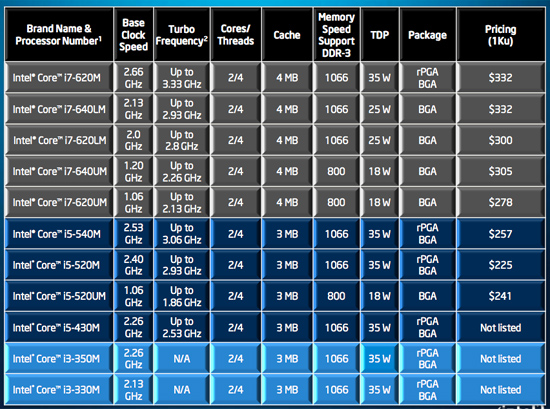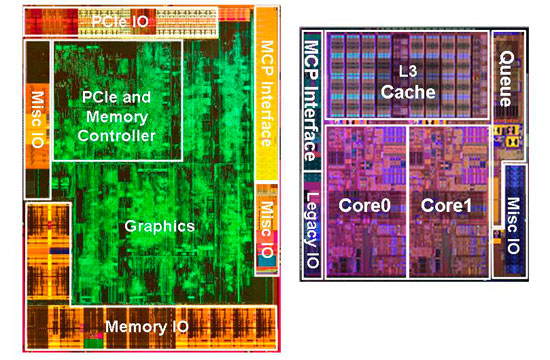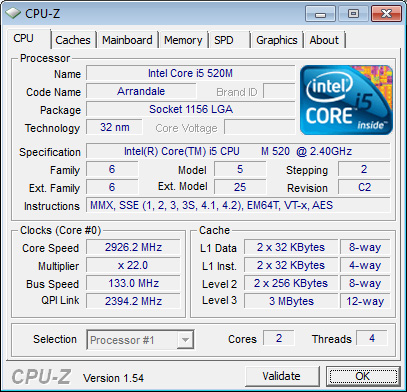Apple's 15-inch Core i5 MacBook Pro: The One to Get?
by Anand Lal Shimpi on April 14, 2010 10:38 PM EST- Posted in
- Mac
- MacBook Pro
- Arrandale
- Core i5
- Laptops
Faster, Not Slower
The 15-inch and 17-inch MacBook Pros offer your choice of Core i5 or i7 processors. If you follow Intel’s model numbers, you can get either a Core i5 520M, 540M or Core i7 620M. These chips run at 2.40GHz, 2.53GHz or 2.66GHz by default.
Wait! But the old 15-inch MacBook Pro ran at 2.53GHz, 2.66GHz or 2.80GHz by default. These new models are slower! After reading that a few times online yesterday, I knew it was time for a quick refresher on microprocessor architecture and performance.

Intel's Arrandale Lineup
There are three ways we can improve CPU performance these days: increase clock speed, increase IPC or increase thread count. The first improvement is the obvious one. Keep all other variables the same, just make the chips run at a higher frequency. The second one requires that we increase the amount of work our CPU does in each clock cycle (increasing the number of instructions completed per clock, or IPC). And the third one is to simply increase the number of simultaneous threads our CPU can handle, either through multiple cores or multiple threads per core.
With Arrandale, the mobile Core i5 and i7, Intel actually used all three tricks to improve performance.
I’ll start with the middle improvement: increasing IPC. Arrandale brings a dual-channel memory controller on-package (it’s actually on the GPU and not the CPU as you may remember). This improves bandwidth which in turn keeps the CPU cores fed with data and thus increases overall IPC.

The Arrandale die. Graphics on left, CPU on right.
The cache hierarchy has changed quite a bit since the Core 2 days. Instead of a large shared L2 cache, each of the two Arrandale cores have their own private 256KB L2 cache. The cache is the fastest of any desktop CPU today requiring only 10 cycles to access it. As I wrote in the past, the L2 is quickly becoming the new L1 so low latency access matters more than size. The catch-all cache moves down a level and Arrandale has a large 4MB L3 cache. On the Core i7s you get the full 4MB, while the i5s disable 1MB leaving you with 3.

There are some instruction and execution level improvements as well, which I’ve detailed here and here. Specific to Arrandale (and the rest of the Westmere family) are new AES instructions designed to accelerate encryption/decryption operations.
The takeaway here is any slight drop in default clock speed is at least partially negated by the increase in performance per clock. If that’s not enough, Arrandale also brings Turbo Boost to Intel’s mobile chips.
These Core i5 and i7 processors have about a million transistors dedicated to power management. It’s a little section of the CPU called the PMU (Power Management Unit). The PMU monitors CPU temperatures, current draw and power consumption. Based on these inputs as well as the current load on the CPU, the PMU can tell the rest of the CPU to increase its clock frequency. The CPU is allowed to increase its operating frequency in 133MHz steps up to a predefined max speed. The max speed is determined by Intel as well as the number of cores that are actively doing work on the chip.
The whole process works like this. If you have all cores active and the workload they’re running isn’t maxing out the CPU’s specified current or power draw, the cores can run at a higher frequency. If you have only one core active, the other core is power gated (effectively shut off) and the active core is allowed to turbo up several bins as long as it remains within its current, temperature and power limits.
The result is that most of the time your 2.40GHz Core i5 runs at 2.66GHz, and if you’re only running single threaded applications you’ll see it bounce from 2.66GHz to 2.80GHz and 2.93GHz. So even if the IPC improvements brought on by Arrandale weren’t enough, you’ll rarely run at your base clock speed when you need the performance. Intel’s Turbo Boost works beautifully in practice and the transition to OS X seems to have gone well.

The 2.40GHz MacBook Pro running at 2.93GHz thanks to Turbo
The final vector for performance improvement is by increasing the number of threads your CPU can work on at once. Threads are nothing more then collections of instructions, which themselves are the basic work units of any CPU. The more threads you can actively complete in parallel, the higher your overall CPU performance.
All Arrandale based Core i5 and i7 CPUs are dual-core processors, that’s two threads right there. Each core however can work on two threads at the same time thanks to Intel’s Hyper Threading bringing us up to four total threads on the new MacBook Pro. Two of those threads are virtual and are simply designed to occupy any idle resources on a core. Hyper Threading doesn’t give the same performance boost as you’d get from four cores, but what it does give you is better-than-dual core performance without the power requirements of four physical cores. For a notebook designed with portability in mind, the tradeoff is ideal.

The downside to all of this? Only the 15-inch and 17-inch models get Arrandale, the 13-inch MacBook Pro sticks with the old Penryn derived Core 2 Duo architecture. If you were holding out for a 13-inch Arrandale model, you’ll have to keep waiting.
| Apple's 2009 Lineup | 13-inch MacBook Pro (Early 2010) | 13-inch MacBook Pro (Late 2009) |
| CPU | Intel Core 2 Duo 2.40GHz | Intel Core 2 Duo 2.26GHz |
| Memory | 4GB DDR3-1066 | 2GB DDR3-1066 |
| HDD | 250GB 5400RPM | 160GB 5400RPM |
| Video | NVIDIA GeForce 320M (integrated) | NVIDIA GeForce 9400M (integrated) |
| Optical Drive | 8X Slot Load DL DVD +/-R | 8X Slot Load DL DVD +/-R |
| Screen Resolution | 1280 x 800 | 1280 x 800 |
| USB | 2 | 2 |
| SD Card Reader | Yes | Yes |
| FireWire 800 | 1 | 1 |
| ExpressCard/34 | No | No |
| Battery | 63.5Whr | 60Whr |
| Dimensions (W x D x H) | 12.78" x 8.94" x 0.95" | 12.78" x 8.94" x 0.95" |
| Weight | 4.5 lbs | 4.5 lbs |
| Price | $1199 | $1199 |










114 Comments
View All Comments
mckirkus - Thursday, April 15, 2010 - link
I have a feeling a lot of the people that use these make movies which requires bulk storage. Even a 256GB SSD would tack on at least $500Pneumothorax - Thursday, April 15, 2010 - link
As being one of those poor saps that "upgraded" to the previous gen MBP and realized I can only run my Intel 160gb G2 reliably at SATA I speeds, this new laptop makes me wary of going for another round of disappointment... So is it fixed?webdev511 - Thursday, April 15, 2010 - link
Envy 15 hasa better GPU ATI 5830
better top end CPU i7 820m
higher ram capacity 16GB
7200 RPM drives standard Dual SSD available
I had high hopes for this rev of MBP, but suffice to say, I'm unimpressed.
flyguyjake - Friday, April 16, 2010 - link
1) Is the display refresh rate 60hz, or 120hz?2) What is the contrast/dynamic contrast ratio?
I phoned Apple today 3x and couldn't get the answers from them. I did however get the following information.
I'm told that if I install boot camp / Win 7 w/USB Blu-Ray drive I can get 1080P on the LCD panel. BUT what's even more exciting is that the MiniDisplay port, via HDMI Griffin adapter, will fully support 1080P video & DTS-HD, TrueHD audio bistream. The i7-620M has PVAP 1.5 (protected video audio path) which is needed for the HD audio & the 330M is HDCP compliant.
What is even MORE exciting is the possibility of 3D !!! The Geforce 330M supports Nvidia 3D vision.
Can this setup play Blu-Ray 3D?
Can this all really be true?
prof.yustaz - Friday, April 16, 2010 - link
Anand Lal Shimpi,"The day has finally come. For nearly a year now I’ve been telling everyone who wanted a new MacBook Pro to wait for Arrandale."
Right. But at the end of the review you also said this: "With a Core i5 and GeForce GT 330M, the new MacBook Pro can get uncomfortably warm under use. I found that the previous generation unibody ran cooler. Intel expects to see Arrandale power consumption go down sometime after the middle of the year with a future rev of the processor. I'm guessing that's what'll be used in the inevitable Fall update to the new MacBook Pro lineup."
Are you saying that Apple will do another refresh in about 5 months just because Intel will release another rev of the CPU? And if that happens, do you expect to see a meaningful reduction of heat and perhaps an even better battery performance? In other words, is it really worth the wait?
"You're paying for the design, build quality and ultimately the right to use OS X. If those things don't matter to you (particularly the OS X item) then you'd be much better off with an ASUS or Dell."
Those things do matter to me, a lot, minus the OS X. But I do not see being much better off with an ASUS or Dell precisely because those things matter to me. Grinding my teeth, I would be willing to sacrifice Apple's design and build quality for function, but ASUS, Dell, HP or Sony do not offer the same battery life and screen resolution as Apple's 15 inch laptop. Am I missing something here? And isn't it true that somewhat comparables offerings from Dell and HP, for example, run even hotter than the most recent Apple's 15 inch laptop?
"If you're curious about what's next, I have two words for you: Sandy Bridge. Due out sometime in Q1 2011, Sandy Bridge looks incredible based on early performance data. No word on when we'll see it in notebooks but if you like torturing yourself, waiting for Sandy Bridge will pay off."
I need a laptop, but I do not have to have it right now. Plus, I do not want to pay over $2,000 for a laptop now if it is going to be blown away in a year or so. Could you please elaborate a little on what can we expect to see in terms of design and function assuming Apple implements Sandy Bridge in a future rev of MBPs? Will they be thinner? Will they have a significantly better battery life and run a lot cooler?
P.S. Also, if you were to purchase the current 15 inch MBP, which combination of the CPU, Memory and HD would you choose to stay below $3,000 (closer to $2,500).
Thank you.
lparsons - Sunday, June 20, 2010 - link
"ASUS, Dell, HP or Sony do not offer the same battery life and screen resolution as Apple's 15 inch laptop."I have to agree with you here. I've been looking around a lot, and while the MBP is expensive, Apple has put together an excellent set of components. They make good choices wrt battery life and performance tradeoffs. The closest thing I can find is the Thinkpad T510 which is a very solid machine, but lacking in 3D graphics performance and I'm not keen on the 16:9 screen. It doesn't have quite the same build quality (though it's still very good) and the batter life isn't quite as good, in part due to the lack of switchable graphics.
I'm hoping to keep the machine for while, so the i7 seems to make sense. Annoyed that the 4GB is 2x2GB, making a future upgrade more expensive than necessary, so I'm debating the 8GB. Would also love an SSD, but I'm thinking that I'll upgrade to that later when the price (hopefully) drops, since I could really use the capacity of the 500GB drive and the Apple SSDs are extremely expensive. Also, the Hi-Res screen is a must for me.
ihouman - Friday, April 16, 2010 - link
Anand, I read this article yesterday and your conclusion between the i5 and i7 were slightly different, as were a few other points. If you had a change of heart, you should append the changes to the end as opposed to removing your original opinion. It creates the image that 'someone' helped persuade your new opinion.Anand Lal Shimpi - Friday, April 16, 2010 - link
Since the original publication I got my hands on a Core i7 based 15-inch model. While I expected the clock speed/cache increase to only result in a less-than-10% performance increase, it ended up doing more than that. It's based on this data (and only this data) that I updated the conclusion, I will edit the conclusion to reflect that this change was made however :)Take care,
Anand
Apolloe - Friday, April 16, 2010 - link
Am I right in assuming that your Left 4 Dead and World of Warcraft tests were done with the i5 15", and not the i7? I assumed this since your info on the GPU there had 256MB, while the i7 MBP has 512MB.If so, any chance of showing the fps results from these games? If not, an answer to the above would be suffice :)
cyrexo - Friday, April 16, 2010 - link
Thanks for the nice review. Could you please measure the battery life with the i7 also?the heat difference between i7 and i5 would also be a nice information which could help me with my decision^